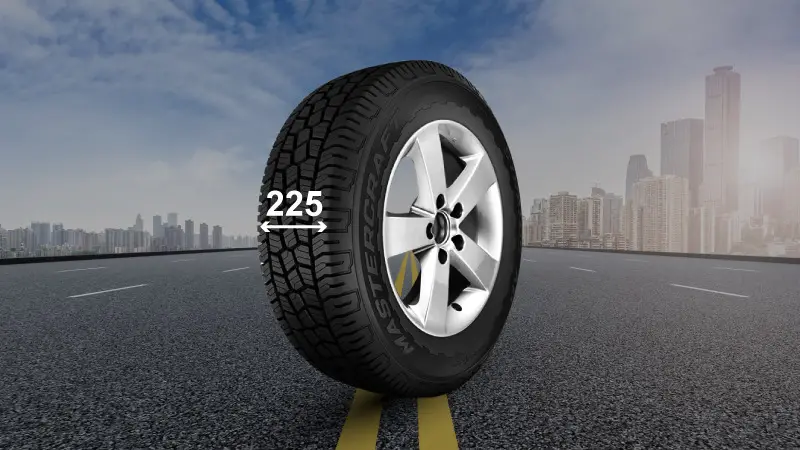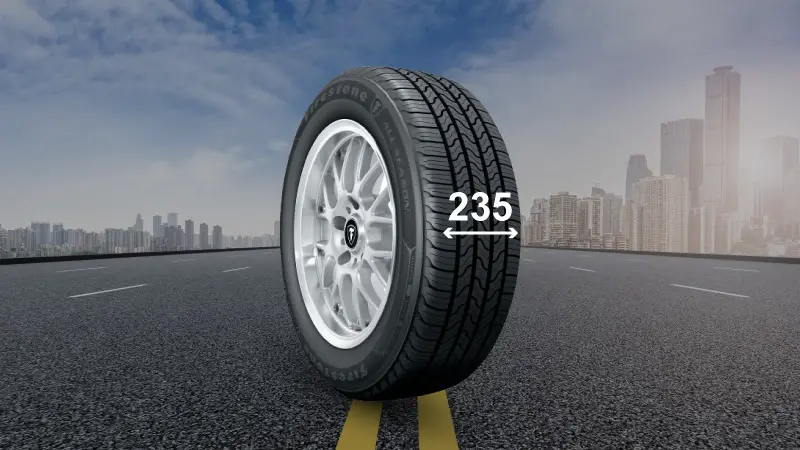For being look-alike, it’s overwhelming to choose a single one between the 225 and 235 tires. But guess what? Despite having similarities in terms of the outlook, we found the difference between 225 and 235 tires on several features.
The core difference is in their fuel–economy. The 225 maximizes the gas mileage, whereas the 235 consumes more fuel. Moreover, it prevents sliding through better handling and gripping performance, while the 225 moves with less rolling force.
To speed up your decision-making, we’ll give you a helping hand by adding the compatibility chart for these two. Thus, it’ll allow you to choose the tire according to your vehicle’s requirements.
So let me cut to the chase!
Quick Comparison Chart: 235 Vs. 225 Tires
Before buying the ideal tires, it’s wise to note down your preferences. Then, go through this chart to checkmark your list of purposes:
| Comparison Criteria | 225 Tires | 235 Tires |
|---|---|---|
| Gas Mileage | 70000 miles | 60000 miles |
| Sidewalls Height | 157 mm | 177 mm |
| Width and Rim | 8.86” (225 mm) | 9.25” (235 mm) |
| Compatibility | Compact and lightweight vehicles | Heavyweight trucks and cars |
| Economic performance | Fuel-efficient | Requires more fuel |
| Carload | Up to 2028 pounds | 2183 pounds |
What Do 225 Tires Mean?

Indeed, some tires often have cryptic names as they include numbers in their title. The 225 tires are no exception! And they’re mainly manufactured for compact cars that provide more mileage on less fuel.
The 225 simply indicates the width of the wheels in millimeters. And they basically come in 225/60R16, 225/45R17, and 225/65R17 models. The numbers that are next to 225 are the aspect ratio and rims’ diameter.
So, a 225/60R16 is a wheel that can fit into a 16-inch rim, and its height is 60% of the total width of the tire. The R is the manufacturing method, which is radial.
Materials Used in 225 Tires
Different manufacturers use different components for 225 tires to provide unique features. However, they all include the materials listed below more or less –
- The rubbers used are mostly natural, along with some synthetic material.
- To strengthen the wheel’s durability, they often add “Carbon Black” during rubber compounding.
- 225 tires contain Silica gel to provide fuel-saving performance.
What Do 235 Tires Mean?

The 235 tires are 10 mm wider than the 225 ones, basically produced for heavy–duty vehicles or cargo. So, these bulky wheels are 235 mm in width, and they mostly come in 235/60R18.
Following 60 means that they are 60% of the width, which refers to their height being 177 mm. Furthermore, these wider tires are taller in terms of sidewalls.
Materials Used in 235 Tires
- Petroleum-based synthetic rubber with other raw materials
- Carbon black, oil, and sulfur aid in elasticity and grip
- Construction materials such as polyester, rayon, etc.
What Are the Differences Between 225 And 235 Tires?
The 225 and 235 wheels are not only different in external looks, but they also differ in performance and internal construction. So here is a detailed dig at the noticeable differences –
Overall Handling
Width, height, traction, and tread wear of the tires are the factors that can aid in or affect the handling of the vehicle. As the 235 mm tires are 9 ¼ inches wider in the tread, they provide more traction and handling.
The 225 tire is 10 mm narrower than the 235. As a result, the former model doesn’t touch the road as much as the other does. Therefore, 225 wheels have lower traction or less ability to hold the ground without sliding.
While driving on slippery and roughly uneven terrain, you can handle the car better with the wider 235 tires. However, we’d say the 225 wheels will slide on uneven roads no matter how hard you brake.
Tire Grip
As the 235 tires have wider tread blocks, they produce more friction between the surfaces. And note that the higher the friction, the better the tire grip will be to minimize risk hazards while riding.
Nonetheless, turning the steering wheel with more force versus the grip the tires produce can affect the traction of the 235 tires. So, the front of the car can slide a bit across the road.
But due to the narrow width of the 225 tires, harsh steering won’t exceed the front tire traction. So, the oversteering grip is better on them, without a doubt!
Weight Capacity
The weight a car is able to carry depends on the construction and size of the tires. Generally, wheels with taller sidewalls and wider treads tend to carry more load without affecting the handling.
As the 235 tires are almost 20 mm taller than the 225 ones, the former can load up to 2183 lbs. And the latter one can withstand not less than 2028 lbs. However, these carload capacities can change upon changing the air pressure.
Also, the internal construction of the 235 is higher-end than the 225 wheels. So, its durable build–quality is able to handle those extra weights.
Width and Height
225 tires are 22.5 cm wider, and their rim width ranges between 7 to 8.86 inches. On the flip side, the 235 tire rims measure from 7.5 to 9.25 inches.
On top of that, the 235 Sidewalls are taller, their height is 177 mm, while the 225 tires consist of around 157 mm.
As narrower wheels have better fuel economy, the 225 is more fuel-efficient than the 235 tires. But it’s equally true that the 235 provides quick responses and control.
Gas Mileage
The point to be noted, narrower tires like 225 ones require less rolling force to maintain the movement of the wheels. As a result, the car sends minimal energy and saves on fuel.
But as the 235 wheels are wider and taller, they won’t be able to keep moving without maximum rolling resistance. Consequently, they’re prone to use more fuel and provide less gas mileage than the other one.
Are 225 And 235 Tires Interchangeable?
As both the tires are different in width and height, they aren’t fully compatible with each other. However, if the aspect ratio and rim diameter are the same for both wheels, you can smoothly interchange them in any vehicle according to your demands.
But without the same rim and aspect, the 225 ones won’t be able to carry the load of large vehicles. And the 235 tires can’t fit compact cars.
So, think twice and take experts’ advice if you’re wondering about using them interchangeably!
225 And 235 Tires’ Compatibility with Cars
The manufacturers have produced 225 and 235 tires for different vehicles, considering the several purposes of the drivers. So, you will not often see them configured in the same car.
Let’s look at this table to understand which vehicle models go best with these two well-known wheels:
| Vehicles | Compatible Tires |
|---|---|
| Fiat 500 | 225 |
| Chevrolet Blazer | 225 |
| Hyundai Accent | 225 |
| Toyota Pickup | 225 |
| Honda Fit | 225 |
| Caprice | 225 |
| Audi A8 | 235 |
| Dodge Charger | 235 |
| Land Cruiser | 235 |
| Land Rover | 235 |
| Dongfeng | 235 |
| FAW X series | 235 |
225 Vs. 235 Tires: Which One Performs Better?
The 225 Vs. 235 tire comparisons can often confuse you when deciding between these two tires. Because both of them have their share of benefits. If you want to experience maximized mileage, the 225 performs better in saving fuel.
For better grip and handling while taking turns or driving over a sloppy area, 235 provides more traction and stability. Moreover, they hardly get wear and tear on potholes!
225 wheels make the driver feel lightweight while taking turns. Because they have narrow and short sidewalls.
So, in terms of fuel consumption and low resistance, the 225 set performs the best. And overall, in grip, traction, quick responsiveness, and external build–quality, the 235 wheels are way ahead of their counterparts.
